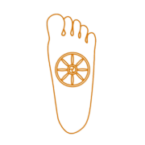This week for the family group we covered the paramī of adhitthāna. This is a quality which like Khanti straddles the definitions of a few english words with its meaning and scope. One aspect is the ability to determine or resolve upon doing something, but the willpower and persistence to stay with our goal despite challenges also comes into play.
It wasn’t hard to think of a dozen examples where this paramī is applied in our daily lives. Whenever we go on a diet, or start an exercise program, or give up a bad habit, or practice to develop a skill – we are making and developing adhitthāna. Perhaps it comes up so often because so many of the things that are really meaningful for our well-being take time and commitment to ripen? This is something meditators know very well.
We’ve already covered one canonical example of this paramī in action with the story of the ascetic Sumedha, who determined to become a fully enlightened Buddha and eventually succeeded to become our own Buddha. One of the most remarkable things is that this determination was so strong and pure it persisted through lifetime after lifetime, for thousands and millions of lifetimes. Many of our aspirations are lucky to last a few weeks, or in the case of many diets, a few days. It’s not to say Sumedha instantly knew exactly how to get to be a Buddha from the beginning, but he at least had seen the goal in the Buddha Dipankara and was determined to work through all the difficulties along the way.
Learning to bear up through difficulties is part of succeeding in our adhitthāna’s. We have to be ready to adapt and appreciate how mistakes can be part of learning. We read a popular children’s book: Bubble Gum Brain – YouTube . The book describes two children, one with a flexible and malleable ‘bubble gum’ brain and another with a blockhead. Sometimes in life we find we are naturally good at some things and bad at others, and we feel like playing it safe and staying with what comes easily. But one of the best skills is the ability to see how we can improve in any task. Even the blockheaded child learns to start to stretch in the end.
We tried this out with a task that few people have diligently cultivated: the ability to solve a maze. We printed out some challenging mazes and then worked through all the mindstates that came up as we got better. A helpful chart of ‘Growth Mindset’ thoughts was close at hand so we could point out defeatist thinking and turn it to constructive thinking.
